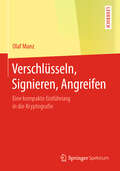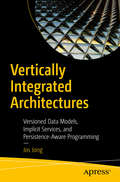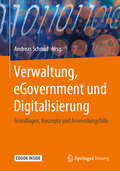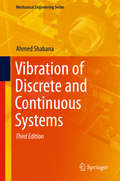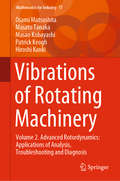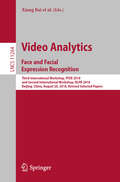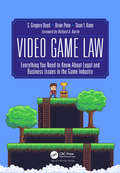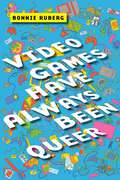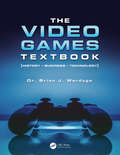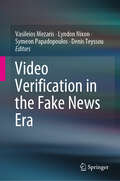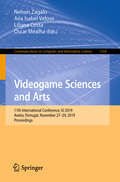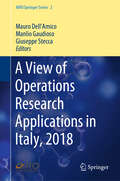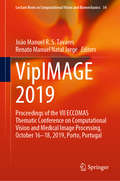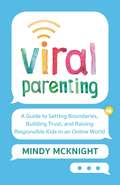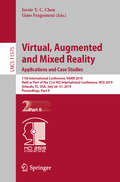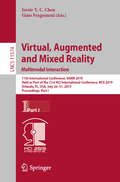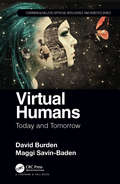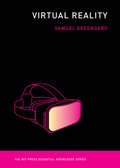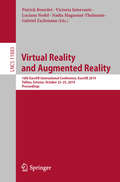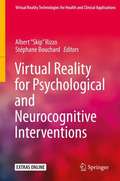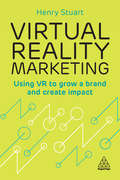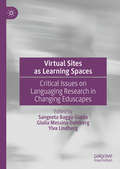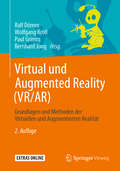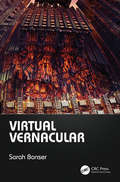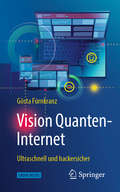- Table View
- List View
Verschlüsseln, Signieren, Angreifen: Eine kompakte Einführung in die Kryptografie
by Olaf ManzDieses Buch erläutert kompakt, ohne theoretischen Überbau und mit möglichst wenig mathematischem Formalismus die wesentlichen Konzepte bei der Verschlüsselung schützenswerter Nachrichten und Daten. Hierbei liegt der Fokus auf der Beschreibung der historisch und für die Praxis wichtigen Chiffrier-, Signatur- und Authentifikationsverfahren. Dabei wird sowohl auf symmetrische Verschlüsselungen als auch auf Public-Key-Chiffren eingegangen. Angesprochen werden jeweils auch die Strategien, mit deren Hilfe man Verschlüsselungen angreift und zu „knacken“ versucht. Besonderer Wert gelegt wird auf die Darstellung des praktischen Einsatzes von Chiffren, insbesondere im alltäglichen Umfeld. Das Buch eignet sich für Arbeitsgruppen an MINT-Schulen und die MINT-Lehrerfortbildung, für Einführungskurse an Hochschulen wie auch für interessierte Schüler und Erwachsene.
Vertically Integrated Architectures: Versioned Data Models, Implicit Services, and Persistence-Aware Programming
by Jos JongUnderstand how and why the separation between layers and tiers in service-oriented architectures holds software developers back from being truly productive, and how you can remedy that problem. Strong processes and development tools can help developers write more complex software, but large amounts of code can still be directly deduced from the underlying database model, hampering developer productivity. In a world with a shortage of developers, this is bad news. More code also increases maintenance costs and the risk of bugs, meaning less time is spent improving the quality of systems. You will learn that by making relationships first-class citizens within an item/relationship model, you can develop an extremely compact query language, inspired by natural language. You will also learn how this model can serve as both a database schema and an object model upon which to build business logic. Implicit services free you from writing code for standard read/write operations, while still supporting fine-grained authorization. Vertically Integrated Architectures explains how functional schema mappings can solve database migrations and service versioning at the same time, and how all this can support any client, from free-format to fully vertically integrated types. Unleash the potential and use VIA to drastically increase developer productivity and quality. What You'll Learn See how the separation between application server and database in a SOA-based architecture might be justifiable from a historical perspective, but can also hold us backExamine how the vertical integration of application logic and database functionality can drastically increase developer productivity and qualityReview why application developers only need to write pure business logic if an architecture takes care of basic read/write client-server communication and data persistenceUnderstand why a set-oriented and persistence-aware programming language would not only make it easier to build applications, but would also enable the fully optimized execution of incoming service requests Who This Book Is For Software architects, senior software developers, computer science professionals and students, and the open source community.
Verwaltung, eGovernment und Digitalisierung: Grundlagen, Konzepte und Anwendungsfälle
by Andreas SchmidEine effizient und effektiv arbeitende öffentliche Verwaltung ist die Voraussetzung für Wirtschaftswachstum und gesellschaftlichen Wohlstand. Hierfür sind eine moderne Informationstechnik und hochqualifiziertes Personal in der öffentlichen Verwaltung wesentliche Voraussetzungen. Die Informationstechnik entwickelt sich derzeit unter dem Begriff der „Digitalisierung“ rasant weiter und die demografische Entwicklung macht die Personalgewinnung herausfordernd. Die Verwaltung steht daher vor großen Herausforderungen. Sucht man für die zugrundeliegenden Fragestellungen nach Antworten, so ergibt sich ein heterogenes Bild von Strategien, Konzepten, Ansätzen und (gescheiterten) Projekten.Dieses Herausgeberwerk schafft Übersicht zu Strategien, Konzepten, Ansätzen und Projekten. Im ersten Teil dieses Buches gehen die Beitragsautoren auf die wichtigsten konzeptionellen Grundlagen ein. Hierzu zählen u. a. die Verwaltungsinformatik als wissenschaftliche Disziplin, strategische Überlegungen und die Schaffung notwendiger organisatorischer und personeller Voraussetzungen in der öffentlichen Verwaltung. Der zweite Teil umfasst Praxisbeispiele aus der öffentlichen Verwaltung als „Best Practices“, u. a. zu den Themenfeldern „Blockchain“, „Big Data“, „Digitalisierte Informationsaufbereitung“, „Automatisierung“ und „Dunkelverarbeitung“. Durch die Kombination von Theorie und Praxis liefert dieses Werk Impulse für die praktische (Projekt-)Arbeit und für weitere wissenschaftliche Diskussionen, die IT-Infrastrukturen im Kontext des eGovernment in Kommunen und Verwaltungsgemeinschaften weiter vorantreiben. Daher richtet sich dieses Buch über Verwaltungsinformatik insbesondere an:IT-Leiter auf Führungsebene sowie Mitarbeiter im Informationsmanagement öffentlicher VerwaltungenDozenten und Lehrende der Informatik und Wirtschaftsinformatik
Vibration of Discrete and Continuous Systems (Mechanical Engineering Series)
by Ahmed ShabanaThis revised, updated textbook adds new focus on computational methods and the importance of vibration theory in computer-aided engineering to fundamental aspects of vibration of discrete and continuous systems covered in the previous two editions of Vibration of Discrete and Continuous Systems. Building on the book’s emphasis on the theory of vibration of mechanical, structural, and aerospace systems, the author’s modifications, including discussion of the sub-structuring and finite element formulations, complete the coverage of topics required for a contemporary, second course following Vibration Theory. The textbook is appropriate for both upper-level undergraduate and graduate courses.
Vibrations of Rotating Machinery: Volume 2. Advanced Rotordynamics: Applications of Analysis, Troubleshooting and Diagnosis (Mathematics for Industry #16)
by Masato Tanaka Osami Matsushita Hiroshi Kanki Masao Kobayashi Patrick KeoghBuilding on the previous volume “Vibrations of Rotating Machinery - Volume 1. Basic Rotordynamics: Introduction to Practical Vibration Analysis,” this book is intended for all practical designers and maintenance experts who are responsible for the reliable manufacturing and operation of rotating machinery. It opens with the dynamics of oil film bearings and their influences on unbalance, vibration resonance and the stability of rotor whirl motion. Subsequently, the book introduces readers to vibration diagnosis techniques for traditional ball bearings and active vibration control from magnetic bearings. Case studies on vibration problems and troubleshooting in industrial turbo machines are then presented and explained, showing rotor designers how to eliminate instability and modify resonance characteristics. Torsional vibration and other coupled vibration phenomena are discussed, and vibration measurement techniques and related signal processing procedures for vibration diagnosis are provided. Our latest three topics are included, covering: (a) the importance of the modeling order reduction (MOR) technique; (b) the approximate evaluation for oil-wheel/whip instability; and (c) a systematic method for shafting-blading coupled vibration analyses. In closing, a 100-question trial test is supplied as an example of the certification of vibration experts based on the ISO standard.
Video Analytics. Face and Facial Expression Recognition: Third International Workshop, FFER 2018, and Second International Workshop, DLPR 2018, Beijing, China, August 20, 2018, Revised Selected Papers (Lecture Notes in Computer Science #11264)
by Xiang Bai Yi Fang Yangqing Jia Meina Kan Shiguang Shan Chunhua Shen Jingdong Wang Gui-Song Xia Shuicheng Yan Zhaoxiang Zhang Kamal Nasrollahi Gang Hua Thomas B. Moeslund Qiang JiThis book constitutes the proceedings of the Third Workshop on Face and Facial Expression Recognition from Real World Videos, FFER 2018, and the Second International Workshop on Deep Learning for Pattern Recognition, DLPR 2018, held at the 24th International Conference on Pattern Recognition, ICPR 2018, in Beijing, China, in August 2018. The 7 papers presented in this volume were carefully reviewed and selected from 9 submissions. They deal with topics such as histopathological images, action recognition, scene text detection, speech recognition, object classification, presentation attack detection, and driver drowsiness detection.
Video Game Law: Everything you need to know about Legal and Business Issues in the Game Industry
by S. Gregory Boyd Brian Pyne Sean F. KaneVideo Game Law is aimed at game developers and industry professionals who want to better understand the industry or are in need of expert legal guidance. Given the rise in international competition, the increasing complexity of video game features, and the explosive growth of the industry in general, game developers can quickly find themselves in serious trouble, becoming vulnerable to copyright infringement claims, piracy, and even security breaches. Not every video game company has the financial resources to retain in-house counsel–which Video Game Law seeks to address by discussing many of the common pitfalls, legal questions, and scenarios facing the industry. S. Gregory Boyd, Brian Pyne, and Sean F. Kane, the most prominent, sought after, and respected video game attorneys in the country, break down the laws and legal concepts that every game developer and industry professional needs to know in order to better protect their game and grow their company. KEY FEATURES:• Provides a solid understanding of intellectual property (IP) concepts and laws, includingcopyright, trademark, trade secret, and other protections that apply to video games andhow each can be employed to protect a company’s unique and valuable IP• Explores cutting edge legal issues that affect the gaming industry, including gambling,virtual currency, privacy laws, the Digital Millennium Copyright Act, tax incentives, andrelevant piracy laws• Provides an overview of legal and privacy vocabulary and concepts needed to navigateand succeed in an industry that is constantly growing and evolving• Provides illustrative examples and legal concepts from the video game industry in everychapter
Video Games Have Always Been Queer (Postmillennial Pop #16)
by Bonnie RubergArgues for the queer potential of video games While popular discussions about queerness in video games often focus on big-name, mainstream games that feature LGBTQ characters, like Mass Effect or Dragon Age, Bonnie Ruberg pushes the concept of queerness in games beyond a matter of representation, exploring how video games can be played, interpreted, and designed queerly, whether or not they include overtly LGBTQ content. Video Games Have Always Been Queer argues that the medium of video games itself can—and should—be read queerly. In the first book dedicated to bridging game studies and queer theory, Ruberg resists the common, reductive narrative that games are only now becoming more diverse. Revealing what reading D. A. Miller can bring to the popular 2007 video game Portal, or what Eve Sedgwick offers Pong, Ruberg models the ways game worlds offer players the opportunity to explore queer experience, affect, and desire. As players attempt to 'pass' in Octodad or explore the pleasure of failure in Burnout: Revenge, Ruberg asserts that, even within a dominant gaming culture that has proved to be openly hostile to those perceived as different, queer people have always belonged in video games—because video games have, in fact, always been queer.
The Video Games Textbook: History, Business, Technology
by Brian J. WardygaThe Video Games Textbook takes the history of video games to another level, with visually-stimulating, comprehensive, and chronological chapters that are relevant and easy to read for a variety of students. Every chapter is a journey into a different era or area of gaming, where readers emerge with a strong sense of how video games evolved, why they succeeded or failed, and the impact they had on the industry and human culture. Written to capture the attention and interest of both domestic and international college students, each chapter contains a list of objectives and key terms, illustrative timelines, arcade summaries, images and technical specifications of all major consoles.
Video Verification in the Fake News Era
by Vasileios Mezaris Lyndon Nixon Symeon Papadopoulos Denis TeyssouThis book presents the latest technological advances and practical tools for discovering, verifying and visualizing social media video content, and managing related rights. The digital media revolution is bringing breaking news to online video platforms, and news organizations often rely on user-generated recordings of new and developing events shared in social media to illustrate the story. However, in video, there is also deception. In today's "fake news" era, access to increasingly sophisticated editing and content management tools and the ease with which fake information spreads in electronic networks, require the entire news and media industries to carefully verify third-party content before publishing it. As such, this book is of interest to computer scientists and researchers, news and media professionals, as well as policymakers and data-savvy media consumers.
Videogame Sciences and Arts: 11th International Conference, VJ 2019, Aveiro, Portugal, November 27–29, 2019, Proceedings (Communications in Computer and Information Science #1164)
by Nelson Zagalo Ana Isabel Veloso Liliana Costa Óscar MealhaThis book constitutes the refereed proceedings of the 11th International Conference on Videogame Sciences and Arts, VJ 2019, held in Aveiro, Portugal, in November 2019. The 20 full papers presented were carefully reviewed and selected from 50 submissions. They were organized in topical sections named: Games and Theories; Table Boards; eSports; Uses and Methodologies; Game Criticism.
A View of Operations Research Applications in Italy, 2018 (AIRO Springer Series #2)
by Mauro Dell’Amico Manlio Gaudioso Giuseppe SteccaThis book presents expert descriptions of the successful application of operations research in both the private and the public sector, including in logistics, transportation, product design, production planning and scheduling, and areas of social interest. Each chapter is based on fruitful collaboration between researchers and companies, and company representatives are among the co-authors. The book derives from a 2017 call by the Italian Operations Research Society (AIRO) for information from members on their activities in promoting the use of quantitative techniques, and in particular operations research techniques, in society and industry. A booklet based on this call was issued for the annual AIRO conference, but it was felt that some of the content was of such interest that it deserved wider dissemination in more detailed form. This book is the outcome. It equips practitioners with solutions to real-life decision problems, offers researchers examples of the practical application of operations research methods, and provides Master’s and PhD students with suggestions for research development in various fields.
VipIMAGE 2019: Proceedings of the VII ECCOMAS Thematic Conference on Computational Vision and Medical Image Processing, October 16–18, 2019, Porto, Portugal (Lecture Notes in Computational Vision and Biomechanics #34)
by João Manuel R. S. Tavares Renato Manuel Natal JorgeThis book gathers full papers presented at the VipIMAGE 2019—VII ECCOMAS Thematic Conference on Computational Vision and Medical Image Processing—held on October 16-18, 2019, in Porto, Portugal. It discusses cutting-edge methods, findings, and applications related to 3D vision, bio- and medical imaging, computer-aided diagnosis, image enhancement, image processing and analysis, virtual reality, and also describes in detail advanced image analysis techniques, such as image segmentation and feature selection, as well as statistical and geometrical modeling. The book provides both researchers and professionals with extensive and timely insights into advanced imaging techniques for various application purposes.
Viral Parenting: A Guide to Setting Boundaries, Building Trust, and Raising Responsible Kids in an Online World
by Mindy McKnightMindy McKnight, YouTube's favorite mom, shares the tools parents need to keep kids safe in their online lives--and shows how to create stronger family relationships as they do. A cross between Jen Hatmaker and Rosalind Wiseman, VIRAL PARENTING is a guide to raising responsible, safe, and communicative kids in the digital world. Mindy shares practical tools for having honest conversations with kids of all ages about privacy, bullying, respectfulness, and family time, while emphasizing the importance of trust and open communication. These strategies are timeless--whether applied to texting, snapping, Facebooking, kiking, or whatever social media platforms await us in the future, this book is ultimately about teaching children about personal responsibility and safety. Mindy shares practical tools for creating family rules for kids of all ages about privacy, bullying, respectfulness, and family time, while emphasizing the importance of trust and open communication. Using family contracts, guided conversations, device checks, and respectful but firm oversight, the McKnights have raised a close knit family and navigated the complexity of being world-wide internet celebrities with grace. McKnight will show any parent of any child or teen how that's done--setting non-negotiable guidelines and offering a savvy perspective toward privacy that audience have been begging for.
Virtual, Augmented and Mixed Reality. Applications and Case Studies: 11th International Conference, VAMR 2019, Held as Part of the 21st HCI International Conference, HCII 2019, Orlando, FL, USA, July 26–31, 2019, Proceedings, Part II (Lecture Notes in Computer Science #11575)
by Jessie Y. C. Chen Gino FragomeniThis two-volume set LNCS 11574 and 11575 constitutes the refereed proceedings of the 11th International Conference on Virtual, Augmented and Mixed Reality, VAMR 2019, held in July 2019 as part of HCI International 2019 in Orlando, FL, USA. HCII 2019 received a total of 5029 submissions, of which 1275 papers and 209 posters were accepted for publication after a careful reviewing process. The 80 papers presented in this volume were organized in topical sections named: multimodal interaction in VR, rendering, layout, visualization and navigation, avatars, embodiment and empathy in VAMR, cognitive and health issues in VAMR, VAMR and robots, VAMR in learning, training and entertainment, VAMR in aviation, industry and the military.
Virtual, Augmented and Mixed Reality. Multimodal Interaction: 11th International Conference, VAMR 2019, Held as Part of the 21st HCI International Conference, HCII 2019, Orlando, FL, USA, July 26–31, 2019, Proceedings, Part I (Lecture Notes in Computer Science #11574)
by Jessie Y. C. Chen Gino FragomeniThis two-volume set LNCS 11574 and 11575 constitutes the refereed proceedings of the 11th International Conference on Virtual, Augmented and Mixed Reality, VAMR 2019, held in July 2019 as part of HCI International 2019 in Orlando, FL, USA. HCII 2019 received a total of 5029 submissions, of which 1275 papers and 209 posters were accepted for publication after a careful reviewing process. The 80 papers presented in this volume were organized in topical sections named: multimodal interaction in VR, rendering, layout, visualization and navigation, avatars, embodiment and empathy in VAMR, cognitive and health issues in VAMR, VAMR and robots, VAMR in learning, training and entertainment, VAMR in aviation, industry and the military.
Virtual Humans: Today and Tomorrow (Chapman & Hall/CRC Artificial Intelligence and Robotics Series)
by David Burden Maggi Savin-BadenVirtual Humans provides a much-needed definition of what constitutes a ‘virtual human’ and places virtual humans within the wider context of Artificial Intelligence development. It explores the technical approaches to creating a virtual human, as well as emergent issues such as embodiment, identity, agency and digital immortality, and the resulting ethical challenges. The book presents an overview of current research and practice in this area, and outlines the major challenges faced by today’s developers and researchers. The book examines the possibility for using virtual humans in a variety of roles, from personal assistants to teaching, coaching and knowledge management, and the book situates these discussions around familiar applications (e.g. Siri, Cortana, Alexa) and the portrayal of virtual humans within Science Fiction. Features Presents a comprehensive overview of this rapidly developing field Provides an array of relevant, real-life examples from expert practitioners and researchers from around the globe in how to create the avatar body, mind, senses and ability to communicate Intends to be broad in scope yet practical in approach, so that it can serve the needs of several different audiences, including researchers, teachers, developers and anyone with an interest in where these technologies might take us Covers a wide variety of issues which have been neglected in other research texts; for example, definitions and taxonomies, the ethical challenges of virtual humans and issues around digital immortality Includes numerous examples and extensive references
Virtual Reality (The MIT Press Essential Knowledge series)
by Samuel GreengardA comprehensive overview of developments in augmented reality, virtual reality, and mixed reality—and how they could affect every part of our lives.After years of hype, extended reality—augmented reality (AR), virtual reality (VR), and mixed reality (MR)—has entered the mainstream. Commercially available, relatively inexpensive VR headsets transport wearers to other realities—fantasy worlds, faraway countries, sporting events—in ways that even the most ultra-high-definition screen cannot. AR glasses receive data in visual and auditory forms that are more useful than any laptop or smartphone can deliver. Immersive MR environments blend physical and virtual reality to create a new reality. In this volume in the MIT Press Essential Knowledge series, technology writer Samuel Greengard offers an accessible overview of developments in extended reality, explaining the technology, considering the social and psychological ramifications, and discussing possible future directions.Greengard describes the history and technological development of augmented and virtual realities, including the latest research in the field, and surveys the various shapes and forms of VR, AR, and MR, including head-mounted displays, mobile systems, and goggles. He examines the way these technologies are shaping and reshaping some professions and industries, and explores how extended reality affects psychology, morality, law, and social constructs. It's not a question of whether extended reality will become a standard part of our world, he argues, but how, when, and where these technologies will take hold. Will extended reality help create a better world? Will it benefit society as a whole? Or will it merely provide financial windfalls for a select few? Greengard's account equips us to ask the right questions about a transformative technology.
Virtual Reality and Augmented Reality: 16th EuroVR International Conference, EuroVR 2019, Tallinn, Estonia, October 23–25, 2019, Proceedings (Lecture Notes in Computer Science #11883)
by Patrick Bourdot Victoria Interrante Luciana Nedel Nadia Magnenat-Thalmann Gabriel ZachmannThis book constitutes the refereed proceedings of the 16th International Conference on Virtual Reality and Augmented Reality, EuroVR 2019, held in Tallinn, Estonia, in October 2019.The 11 full papers and 5 short papers presented together with 8 scientific posters were carefully reviewed and selected from 54 submissions. The papers are organized in topical sections named: Immersive Interaction; Training, Teaching and Learning; Industrial Applications and Data Analysis; Perception, Cognition and Evaluation; and Scientific Posters.
Virtual Reality for Psychological and Neurocognitive Interventions (Virtual Reality Technologies for Health and Clinical Applications)
by Stéphane Bouchard Albert “Skip” RizzoThis exciting collection tours virtual reality in both its current therapeutic forms and its potential to transform a wide range of medical and mental health-related fields. Extensive findings track the contributions of VR devices, systems, and methods to accurate assessment, evidence-based and client-centered treatment methods, and—as described in a stimulating discussion of virtual patient technologies—innovative clinical training. Immersive digital technologies are shown enhancing opportunities for patients to react to situations, therapists to process patients’ physiological responses, and scientists to have greater control over test conditions and access to results. Expert coverage details leading-edge applications of VR across a broad spectrum of psychological and neurocognitive conditions, including: Treating anxiety disorders and PTSD.Treating developmental and learning disorders, including Autism Spectrum Disorder,Assessment of and rehabilitation from stroke and traumatic brain injuries.Assessment and treatment of substance abuse.Assessment of deviant sexual interests.Treating obsessive-compulsive and related disorders.Augmenting learning skills for blind persons. Readable and relevant, Virtual Reality for Psychological and Neurocognitive Interventions is an essential idea book for neuropsychologists, rehabilitation specialists (including physical, speech, vocational, and occupational therapists), and neurologists. Researchers across the behavioral and social sciences will find it a roadmap toward new and emerging areas of study.
Virtual Reality Marketing: Using VR to Grow a Brand and Create Impact
by Henry StuartIf a picture is worth a thousand words, then virtual reality (VR) is priceless. This new medium is booming - by 2025, the industry is expected to become bigger than TV. Virtual Reality Marketing is a comprehensive exploration of all things VR, providing readers with everything they need to know about the current VR landscape, and the unprecedented opportunity it offers brands to create unique emotional connections with consumers. A truly comprehensive guide, Virtual Reality Marketing covers all aspects of the industry, including interactive and passive VR, 360 video, social VR marketing, and the role that influencers and bloggers are set to play in its development. It also looks to the future - exploring how VR is evolving and the changes it will undergo in the future. Virtual Reality Marketing is the only complete guide to VR marketing available, written by a recognized industry expert who has facilitated VR coverage for major international brands including Facebook, Audi, Google and Mercedes F1. Packed with fascinating case studies, tips and strategies, this text is the leading resource for any reader looking to incorporate VR in their own marketing campaigns.
Virtual Sites as Learning Spaces: Critical Issues on Languaging Research in Changing Eduscapes
by Sangeeta Bagga-Gupta Giulia Messina Dahlberg Ylva LindbergThis volume fills a gap in the literature between the domains of Communication Studies and Educational Sciences across physical-virtual spaces as they intersect in the 21st century. The chapters focus on “languaging” - communicative practices in the making - and its intersection with analogue and virtual learning spaces, bringing together studies that highlight the constant movement between analogue-virtual dimensions that continuously re-shape participants' identity positionings. Languaging is understood as the deployment of one or more than one language variety, modality, embodiment, etc in human meaning-making across spaces. Languaging activities are explored through a multitude of literary artefacts, genres, media, and modes produced in and across sites. The authors go beyond “best practice” approaches and instead present “how-to-explore” communicative practices for researchers, learners and teachers. This book will be of interest to readers situated in the areas of literacy, literature, bi/multilingualism, multimodality, linguistic anthropology, applied linguistics, and related fields. Chapters 2, 5, 8 and 12 are open access under a CC BY 4.0 license at link.springer.com.
Virtual und Augmented Reality: Grundlagen und Methoden der Virtuellen und Augmentierten Realität (Examen. Press Ser.)
by Ralf Dörner Wolfgang Broll Paul Grimm Bernhard JungLernen Sie mit diesem Buch die Grundlagen der Virtuellen und Augmentierten Realität kennen Dieses Buch über die Virtuelle und Augmentierte Realität ist sowohl für Praktiker und Interessierte im Selbststudium als auch für Studierende geeignet. Letztere können es hervorragend als Begleitlektüre für entsprechende Lehrveranstaltungen, zum Beispiel in der Informatik nutzen. Die zweite Auflage wurde umfassend erneuert und erweitert. Mit ihrer Hilfe kann der Leser sein Verständnis für das Themengebiet rund um die VR und AR vertiefen. Thematisch schneidet das Buch viele Bereiche der Virtuellen und Augmentierten Realität an, darunter beispielsweise Wahrnehmungsaspekte der AR, Interaktionen in einer virtuellen Welt oder die mathematischen Basics für VR und AR. (105)
Virtual Vernacular
by Sarah BonserLearn to see the patterns and relationships in visual mediums and buildings as you push the boundaries of design. Sarah Bonser’s Virtual Vernacular breaks the barriers between architectural theory and game design. The text explores the way in which architecture can convey history, culture, and emotion to occupants, audience members, and players. Divided into three sections, the text guides the reader on how to tackle creative problem solving and development strategy. Key Features: Architectural theory is hard to navigate, and this approach is an accessible way to start learning it. Learn more specifically how pop culture parodies these design theories. Find ways to solve abstract design problems by using the built environment as a case study. Learn about technical limitations on the built environment that visually impact the look and feel of spaces. Each piece of architectural theory comes with abstracts and applications, which is a more organized and network-style way to teach an otherwise long-winded subject.
Vision Quanten-Internet: Ultraschnell und hackersicher
by Gösta FürnkranzDie Zukunft des Internets kann fantastisch werden! Mit neuer Quantentechnologie sind hackersicherer Informationsaustausch sowie ultraschnelle Datenverarbeitung möglich. Die Basis bildet Albert Einsteins „Quantenspuk“. Dabei handelt es sich nicht um Zauberei, sondern um knallharte Wissenschaft. Dieses Buch unternimmt eine faszinierende Reise durch die Welt unserer Quantenzukunft – vom ersten „Quantensatelliten“ zum Hochsicherheitsinternet, bis hin zur Quantencloud und weiteren, teils futuristischen Applikationen.Der Autor führt den Leser durch grundlegende quantenphysikalische Zusammenhänge, erklärt die Konzepte von Quantencomputer, -Kryptografie, -Teleportation und stellt ihren Bezug zum Quanteninternet her. Besonders die gesellschaftliche Relevanz, technische Schwierigkeiten und Implementierungsbeispiele werden unter die Lupe genommen. Thematisch passende Anekdoten lockern den Text auf. Mit diesem Buch erfahren Sie, wie Quanten das Internet revolutionieren können! "… in lebendiger Sprache wird der aktuelle Stand der Forschung in seiner ganzen Breite und Pracht dargestellt – lesenswert und kurzweilig!" Rupert Ursin, Gruppenleiter und Vizedirektor des Instituts für Quantenoptik und Quanteninformation, Wien
